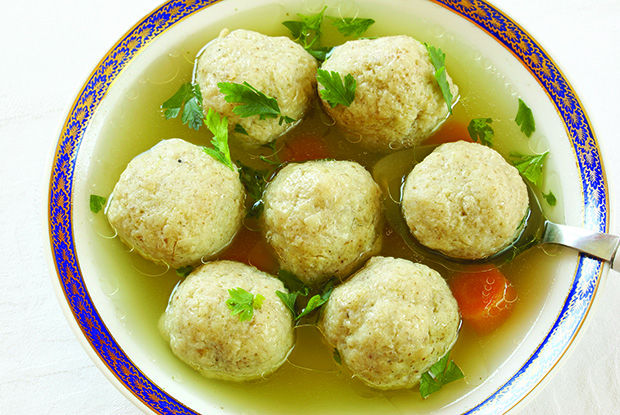Creative matzah balls for your Passover seder
Published March 25, 2015
I am often reminded that everyday coincidences affect our lives or, in the case of this food columnist, the themes of my columns. Let me explain.
I received notice that one of my favorite Israeli chefs, Einat Admony, would be hosting a Passover seder at one of her New York restaurants, Balaboosta (I reviewed her cookbook by the same name in 2013). Her menu, which was a mouthwatering fusion of traditional Asian cuisine and contemporary Sephardic Passover dishes, had me at hello. I was especially taken by her Duck Matzah Ball Soup – matzah balls stuffed with Baharat duck confit, water spinach and foie gras.
My first thought: Who stuffs matzah balls? And then: Who stuffs them with foie gras? But then, and here comes that coincidence, I remembered my mother telling me that my grandmother Hannah used to stuff matzah balls with chopped liver. She explained that her mother prepared that dish as a cook in a children’s home in Stuttgart, Germany, after their liberation from Auschwitz.
ADVERTISEMENT
Food aficionados may be offended that I would put foie gras in the same category as chopped liver, but let’s face it: The liver of a fowl, wrapped in matzah meal batter and served in a bowl of broth made from cooked ducks or chickens, is still liver. And while you might be wary of tweaking what you believe to be an age-old tradition, please understand that our conception of the iconic matzah ball is of fairly recent vintage.
The Yiddish word for matzah balls is knaidelach, which comes from the German word for dumpling, knödel. According to Jewish food historian Gil Marks, knödel can be traced back to 12th century Italy. In Italy, and later throughout Europe, these dumplings were the food of the poor, made by combining stale bread with water, binding the mixture together with an egg, cooking them in water and producing enough dumplings to feed a hungry family.
Because Jews could not eat leavened bread during Passover, they crushed matzahs and used them in place of the stale bread. It was only when the folks at Manischewitz began mass-producing finely ground matzah meal in boxes in the 1930s did matzah balls, as we know them today, emerge.
ADVERTISEMENT
So back to those stuffed matzah balls. If your family has an aversion to liver, you can create a filling from ground chicken, beef or lamb. And if you don’t want to potschke with stuffing matzah balls, you could simply experiment by adding new flavors to your standard matzah ball recipe.
Creole matzah balls incorporate fresh ginger, garlic, green onions and parsley. A Sephardic version might feature saffron and cilantro. You could substitute schmaltz, melted bone marrow or goose fat for the oil. Or add one to two teaspoons of finely minced garlic, fresh parsley, cilantro, basil or chopped caramelized onions to the mix. Or even move beyond the standard salt and pepper seasonings to some more assertive spices, such as cumin, cayenne pepper, coriander or curry powder.
To add visual zing, consider adding one of the following to your uncooked matzah ball mixture: 3 ounces of finely chopped fresh spinach (green); three tablespoons of tomato paste (red); or one teaspoon of ground turmeric (yellow). The recipes for these three variations are included in “Passover by Design” by Susie Fishbein.
The best vessel for your matzah balls is a rich broth, be it chicken or vegetable. Building flavors for either variety requires an abundance of fresh vegetables or aromatics. These include carrots, onions, celery or celery root, parsnips, leeks, rutabagas and sweet potatoes. And nothing enhances your broth more than fresh herbs, such as parsley, dill and thyme.
For a clear broth, be sure to cook it a day in advance, chill it overnight, skim off the fat the next day and strain the broth in a fine mesh strainer or in a colander lined with cheese cloth.
As coincidence would have it, I’ll be making matzah balls stuffed with chopped liver this Passover, just the way my Baba Hannah did 70 years ago. I have included two stuffed matzah ball recipes along with a couple of easy-to-prepare, big-on-flavor sides to accompany your main course.
Chag Sameach.
Margi Lenga Kahn is the mother of five and grandmother of five. A cooking instructor at the Kitchen Conservatory, she is working on a project to preserve the stories and recipes of heritage cooks. She welcomes your comments and suggestions at [email protected].
















